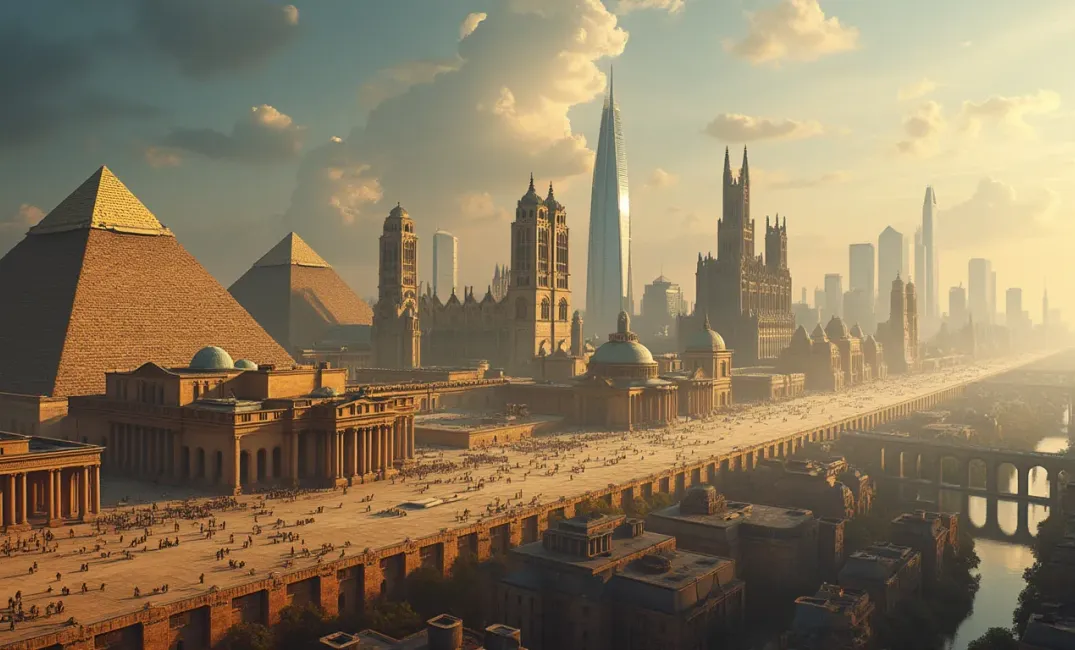Introduction: Building the Testament of Humanity
"Architecture is the learned game, correct and magnificent, of forms assembled in the light." — Le Corbusier
Architecture stands as a testament to human creativity, resilience, and cultural expression throughout history. From the majestic pyramids of ancient Egypt to the sleek skyscrapers of modern cities, the built environment reflects the social, technological, and aesthetic values of societies through time. As both shelter and symbol, architecture bridges the past, present, and future, shaping the way individuals and communities interact with their environment and each other.
This entry explores the transformative journey of architecture, examining its role in defining civilizations, expressing identity, and envisioning sustainable futures. Through triumphs of design and engineering, architecture captures humanity's quest for beauty, function, and meaning.
Ancient Architecture: Foundations of Civilization
Monumental Beginnings
- Pyramids of Giza: Among the enduring wonders of the ancient world, the pyramids symbolize architectural ambition and the spiritual beliefs of Egypt. These monumental structures demonstrate advanced understanding of geometry, labor organization, and religious devotion.
- Ziggurats and Temples: In Mesopotamia, ziggurats functioned as religious centers, showcasing architectural innovation and theocratic society. Concurrently, ancient Greek temples, such as the Parthenon, epitomized symmetry and proportion, reflecting philosophical ideals of harmony and balance.
The Wonders of Rome
- Engineering Mastery: Roman architecture exemplified engineering prowess, with innovations such as the arch, vault, and concrete enabling the construction of enduring structures like the Colosseum and aqueducts.
- Urban Planning: Roman cities were meticulously planned with forums, baths, and amphitheaters, highlighting social and political organization. Such advancements facilitated the Roman Empire's expansion and integration across diverse regions.
Medieval and Renaissance Innovations: Bridging Cultures
The Gothic Flourish
- Cathedrals of Light: Gothic architecture soared to new heights with cathedrals like Notre-Dame, emphasizing verticality and light. Innovations such as flying buttresses and ribbed vaults created vast, illuminated interiors that inspired spirituality and community.
- Symbolism and Ornamentation: Rich in symbolism, Gothic cathedrals were adorned with sculptures and stained glass, serving as narratives of biblical stories and local history, accessible to all social classes.
The Renaissance Revival
- Rational Beauty: The Renaissance marked a revival of classical ideals, with architects like Brunelleschi and Palladio merging symmetry with perspective. The Basilica of Saint Peter's in Rome, for instance, remains a masterpiece of form and function.
- Integration of the Arts: Architecture during this period synergized with other art forms, celebrating humanism and creativity while laying the groundwork for future residential and civic architecture.
Modern Movements: From Functionality to Form
19th Century Transformations
- Industrial Age Impact: The Industrial Revolution transformed architectural practice and theory, introducing new materials like steel and glass. Structures like the Crystal Palace embodied industrial capabilities and aesthetic potential.
- Rise of Skyscrapers: The advent of steel framing enabled the rise of skyscrapers, with the Home Insurance Building in Chicago pioneering urban verticality—reshaping cityscapes and redefining office buildings as icons of progress.
20th Century Avant-Garde
- Modernist Visions: Pioneers like Le Corbusier and Frank Lloyd Wright championed functionalism and organic architecture, blending form with environment, as seen in the Villa Savoye and Fallingwater.
- Architectural Rebellion: Movements such as Bauhaus sought to dissolve barriers between artists and craftsmen, emphasizing design for everyday life. Concurrently, Brutalism experimented with concrete's texture and monumentality in cultural and civic projects.
Sustainable Futures: Envisioning Resilient Designs
Eco-Architecture
- Green Building Practices: Contemporary architecture increasingly embraces sustainability, with emphasis on energy efficiency, renewable materials, and harmonious integration with natural landscapes. The Edge in Amsterdam exemplifies this with intelligent design optimizing energy consumption.
- Vertical Forests: Projects like Stefano Boeri's Bosco Verticale integrate urban greenery into high-rises, promoting biodiversity, air quality, and urban aesthetics.
Smart Cities and Digital Realms
- Technological Integration: Architecture enters the digital age with smart technologies enhancing functionality: adaptive façades, AI-driven building management, and zero-carbon footprints redefine urban living in developments like Masdar City.
- Challenges and Opportunities: As cities grow, architects balance need for dense, efficient spaces with equitable access and cultural integrity, ensuring designs account for future urban and social dynamics.
Conclusion: Architecture as a Guardian of Humanity's Heritage
"The mother art is architecture. Without an architecture of our own, we have no soul of our own civilization." — Frank Lloyd Wright
Architecture, as both art and science, captures humanity’s spirit, anchoring societies in time while inviting progress. From ancient wonders through modern marvels, the legacy of architecture is a chronicle of human ingenuity and collective aspiration.
As you navigate this legacy, consider architecture's role in shaping your environment and experiences. Your constructions bear witness to aspirations, priorities, and identities, crafting histories in concrete and glass as visions become reality.
In preserving and advancing architectural heritage, you continue to honor the expansive journey of human creativity, crafting spaces that foster connection, innovation, and resilience—a beacon for future generations and a testament to enduring possibility.
SUSTAINABILITY, MODERNISM, HISTORY, ANCIENT, ARCHITECTURE, CULTURE, ENGINEERING, INNOVATION, DESIGN, TECHNOLOGY

